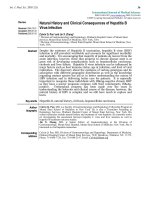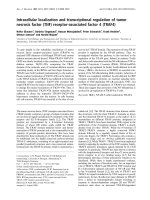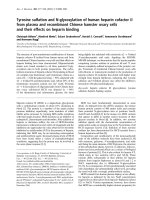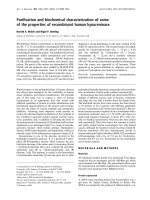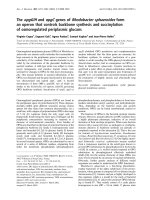Báo cáo y học: " Local epidemiology and clinical manifestations of Lyme disease"
Bạn đang xem bản rút gọn của tài liệu. Xem và tải ngay bản đầy đủ của tài liệu tại đây (167.5 KB, 1 trang )
Int. J. Med. Sci. 2009, 6
123
I
I
n
n
t
t
e
e
r
r
n
n
a
a
t
t
i
i
o
o
n
n
a
a
l
l
J
J
o
o
u
u
r
r
n
n
a
a
l
l
o
o
f
f
M
M
e
e
d
d
i
i
c
c
a
a
l
l
S
S
c
c
i
i
e
e
n
n
c
c
e
e
s
s
2009; 6(3):123
© Ivyspring International Publisher. All rights reserved
Short Communication
Local epidemiology and clinical manifestations of Lyme disease
Walter O. Pavan
Regional Referral Centre for Borreliosis, Ravenna (Italy)
Published: 2009.03.19
Lyme disease is caused by the bacterium
Borrelia
burgdorferi
and is transmitted to humans by the bite
of infected black-legged ticks. Typical symptoms in-
clude fever, headache, fatigue, and a characteristic
skin rash called erythema migrans. If left untreated,
infection can spread to joints, the heart, and the
nervous system. Lyme disease is diagnosed based on
symptoms, physical findings (e.g., rash), and the pos-
sibility of exposure to infected ticks (Figure 1); labo-
ratory testing is helpful in the later stages of disease.
Most cases of Lyme disease can be treated
successfully with a few weeks of antibiotics However,
there is no acquired immunity after the recovery and
there is no current useful vaccine available. In Italy
the vaccine for Lyme disease was withdrawn in the
2002. Steps to prevent Lyme disease include using
insect repellent, removing ticks promptly, landscap-
ing, and integrated pest management. The ticks
Ixodes ricinus that transmit Lyme disease can occa-
sionally transmit other tick-borne diseases as well.
In the USA Lyme disease is endemic in the East
Coast and in the region of Lakes with a top in Con-
necticut. Canada, Japan, Cina, Australia are also en-
demic areas. In Italy the first Lyme case was described
in 1983 and 2616 cases have been described from 1986
to 2001. Emilia Romagna is an endemic area, due to
the environment with lakes, woods and marshy areas.
In this Region 722 cases were reported from 1996 to
2007.
Lyme disease is important for Public Health: it is
the most widespread disease transmitted by a vector;
its transmission is increasing all over the world; there
is high risk of exposure in the population; it is possible
to avoid the chronic, disabling disease infection
causes.
When a tick bites there are some important
things to do: rapid removal of the tick; give the right
information; do not give antibiotics immediately;
control the spot daily for 30-40 days at least. Only
tweezers should be used for tick removal. Application
of heat (matches, etc) and application of various sub-
stances such as oil, petrol, petroleum, tryelin, acids
and so on must be avoided.
Lyme disease does not necessarily follow when
someone is bitten by a tick: only 3-10% of ticks are
infected and the risk of catching the disease is very
low if removal is done correctly and the patient is
immunocompetent. If the patient has no symptoms
after 30-40 days he/she may be considered healthy. If
the patients show symptoms after this period, it is
necessary to request examination by a specialist.
Figure 1: Typical erythematic reaction around a tick bite in
a young boy.
